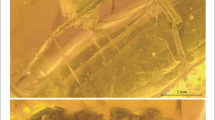Abstract
Recent studies on the ant phylogeny are mainly based on the molecular analyses of extant subfamilies and do not include the extinct, only Cretaceous subfamily Sphecomyrminae. However, the latter is of major importance for ant relationships, as it is considered the most basal subfamily. Therefore, each new discovery of a Mesozoic ant is of high interest for improving our understanding of their early history and basal relationships. In this paper, a new sphecomyrmine ant, allied to the Burmese amber genus Haidomyrmex, is described from mid-Cretaceous amber of France as Haidomyrmodes mammuthus gen. and sp. n. The diagnosis of the tribe Haidomyrmecini is emended based on the new type material, which includes a gyne (alate female) and two incomplete workers. The genus Sphecomyrmodes, hitherto known by a single species from Burmese amber, is also reported and a new species described as S. occidentalis sp. n. after two workers remarkably preserved in a single piece of Early Cenomanian French amber. The new fossils provide additional information on early ant diversity and relationships and demonstrate that the monophyly of the Sphecomyrminae, as currently defined, is still weakly supported.




Similar content being viewed by others
References
Astruc C, Julien JF, Errard C, Lenoir A (2004) Phylogeny of ants (Formicidae) based on morphology and DNA sequence data. Mol Phylogenet Evol 31:880–893
Baroni Urbani C, Bolton B, Ward PS (1992) The internal phylogeny of ants (Hymenoptera: Formicidae). Syst Entomol 17:301–329
Bolton B (1990a) Army ants reassessed: the phylogeny and classification of the doryline section (Hymenoptera: Formicidae). J Nat Hist 24:1339–1364
Bolton B (1990b) Abdominal characters and status of the cerapachyine ants (Hymenoptera: Formicidae). J Nat Hist 24:53–68
Bolton B (1995) A new general catalogue of the ants of the world. Harvard University Press, Cambridge, MA
Bolton B (2003) Synopsis and classification of Formicidae. Mem Am Entomol Inst 71:1–370
Brady SG, Schultz TR, Fisher BL, Ward PS (2006) Evaluating alternative hypotheses for the early evolution and diversification of ants. Proc Natl Acad Sci U S A 103:18172–18177
Brothers DJ (1975) Phylogeny and classification of the Aculeate Hymenoptera, with special reference to Mutillidae. Univ Kansas Sci Bull 50:483–648
Brothers DJ (1999) Phylogeny and evolution of wasps, ants and bees (Hymenoptera, Chrysidoidea, Vespoidea and Apoidea). Zool Scr 28:233–250
Brothers DJ, Carpenter JM (1993) Phylogeny of Aculeata: Chrysidoidea and Vespoidea (Hymenoptera). J Hymenoptera Res 2:227–302
Crozier RH (2006) Charting uncertainty about ant origins. Proc Natl Acad Sci U S A 103:18029–18030
Dlussky GM (1996) Ants (Hymenoptera: Formicidae) from Burmese amber. Paleont J 30:449–454
Engel MS, Grimaldi DA (2005) Primitive new ants in Cretaceous amber from Myanmar, New Jersey, and Canada (Hymenoptera: Formicidae). Am Mus Novit 3485:1–23
Grimaldi DA, Agosti D, Carpenter JM (1997) New and rediscovered primitive ants (Hymenoptera: Formicidae) in Cretaceous amber from New Jersey, and their phylogenetics relationships. Am Mus Novit 3208:1–43
Hölldobler B, Wilson EO (1990) The ants. Harvard University Press, Cambridge
Jolivet P (1996) Ants and plants—an example of coevolution. Backhuys, Leiden
Moreau CS, Bell CD, Vila R, Archibald SB, Pierce NE (2006) Phylogeny of the ants: diversification in the age of angiosperms. Science 312:101–104
Nel A (1997) The probabilistic inference of unknown data in phylogenetic analysis. In: Grancolas P (ed) The origin of biodiversity in insects: phylogenetic tests of evolutionary scenarios. Mém Mus Natl Hist Nat, Paris 173, pp 305–327
Néraudeau D, Perrichot V, Dejax J, Masure E, Nel A, Philippe M, Moreau P, Guillocheau F, Guyot T (2002) Un nouveau gisement à ambre insectifère et à végétaux (Albien terminal probable): Archingeay (Charente-Maritime, France). Geobios 35:233–240
Néraudeau D, Allain R, Perrichot V, Videt B, De Broin F, Guillocheau F, Philippe M, Rage JC, Vullo R (2003) Découverte d'un dépôt paralique à bois fossiles, ambre insectifère et restes d'Iguanodontidae (Dinosauria, Ornithopoda) dans le Cénomanien inférieur de Fouras (Charente-Maritime, Sud-Ouest de la France). CR Palevol 2:221–230
Ohnishi H, Imai HT, Yamamoto MT (2003) Molecular phylogenetic analysis of ant subfamily relationships inferred from rDNA sequences. Genes Genet Syst 78:419–425
Ouellette GD, Fisher BL, Girman DJ (2006) Molecular systematics of basal subfamilies of ants using 28S rRNA (Hymenoptera: Formicidae). Mol Phylogenet Evol 40:359–369
Perrichot V (2005) Environnements paraliques à ambre et à végétaux du Crétacé nord-aquitain (Charentes, Sud-Ouest de la France). Mém Géosciences Rennes 118:1–310
Perrichot V, Lacau S, Néraudeau D, Nel A (2007) Fossil evidence for the early ant evolution. Naturwissenschaften DOI 10.1007/s00114-007-0301-8
Ross AJ, York PV (2000) A list of type and figured specimens of insects and other inclusions in Burmese amber. Bull Nat Hist Mus, London (Geol) 56:11–20
Saux C, Fisher BL, Spicer GS (2004) Dracula ant phylogeny as inferred by nuclear 28S rDNA sequences and implications for ant systematics (Hymenoptera: Formicidae: Amblyoponinae). Mol Phylogenet Evol 33:457–468
Shattuck SO (1992) Higher classification of the ant subfamilies Aneuretinae, Dolichoderinae, and Formicinae. Syst Entomol 17:199–206
Taylor RW (1978) Nothomyrmecia macrops: a living fossil-ant rediscovered. Science 201:979–985
Ward PS (1990) The ant subfamily Pseudomyrmecinae (Formicidae): generic revision and relationship to other Formicidae. Syst Entomol 15:449–489
Ward PS, Brady SG (2003) Phylogeny and biogeography of the ant subfamily Myrmeciinae (Hymenoptera: Formicidae). Invertebr Syst 17:361–386
Wilson EO, Carpenter FM, Brown WL Jr (1967) The first Mesozoic ants, with the description of a new subfamily. Psyche 74:1–19
Acknowledgements
We are grateful to Eric Depré for donating the piece of amber from Fouras with the sphecomyrmines reported here. We thank Gaël de Ploëg (MNHN) for preparation of some type material; Gilbert Hodebert (MNHN) for drawings of some specimens; Carl Findley for checking English; and anonymous reviewers for useful comments. This work was supported by the CNRS programme ECLIPSE II on “Cretaceous climates and ecosystems” and by Alexander von Humboldt Foundation for VP.
Author information
Authors and Affiliations
Corresponding author
Rights and permissions
About this article
Cite this article
Perrichot, V., Nel, A., Néraudeau, D. et al. New fossil ants in French Cretaceous amber (Hymenoptera: Formicidae). Naturwissenschaften 95, 91–97 (2008). https://doi.org/10.1007/s00114-007-0302-7
Received:
Revised:
Accepted:
Published:
Issue Date:
DOI: https://doi.org/10.1007/s00114-007-0302-7




